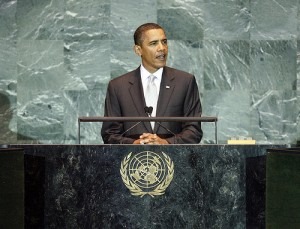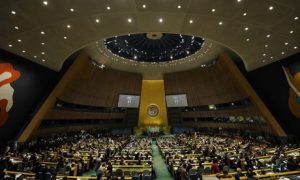Blog
Posted on September 27, 2010
Submitted by Linda Martin
Social and economic factors that restrict or deny access to education include gender bias, lack of schools, lack of trained teachers, demands on children’s time to work, drop-out rates, and fee based education which families cannot afford. Geography also plays a role. Per the Millennium Development Progress Report 2010 “household data from 42 countries also show that rural children are twice as likely to be out of school as children living in urban areas”. What can be done?
- Abolish primary and secondary school fees. When primary school fees were eliminated in Burundi, enrollment increased threefold (since 1999) and reached 99 per cent in 2008.
- Promote linkages across sectors. Couple functional literacy programs to skills development and income generation. In Malawi, the Ministry of Women and Child Development implemented the Sustainable Social and Economic Empowerment Programme for Poverty Reduction (SSEEP) to tackle the problems of illiteracy, environmental degradation and poverty reduction. The approach combined the participatory REFLECT (Regenerated Freirean Literacy through Empowering Community Techniques) methodology with functional literacy and the development of livelihood activities. In this methodology, participants are central to the implementation of the program, and locally-available materials and resources are adapted, mostly by the participants themselves, as aids in the learning process.
- Incorporate literacy and education as a keystone in poverty reduction frameworks and as needed, in education reform. Mauritania’s National Strategy for the Eradication of Illiteracy (2006-2015) “reinforces the importance of literacy as a full-fledged component of the revised Poverty Reduction Strategy Framework and as an essential ingredient of sustainable development”. In Sierra Leone, NGOs collaborated to combine literacy provision with conflict resolution and peace-building.
- Focus efforts on the least developed countries. Per the February, 2010 General Assembly report, this would include landlocked developing countries, nations vulnerable to natural disasters, and areas of conflict or post conflict.
Other suggestions include new school construction, teacher training, insuring schools are safe, and developing incentives for youth to stay in school through secondary level.
Washington State Organizations Making a Difference
A few of the many organizations in Washington state that support global literacy and education as a means of poverty alleviation include: All As One, which offers orphaned children in Sierra Leone a loving home, health care and education, Ayni Education International, which has built 18 new schools in Afghanistan and equipped 20 others, serving about 25,000 Afghan students; and Bahia Street, which ”breaks cycles of poverty and violence through quality education for impoverished girls and young women living in Salvador, Brazil”. For information on other Global Washington members, please refer to our directory of organizations.
Related Links
Education and the Millennium Development Goals
Progress for Children – Achieving the MDGs with Equity
Millennium Development Progress Report 2010
The Global Literacy Challenge
MDG Info 2010
MDG Data Wizard
United Nations Girls Education Initiative
UNICEF-Basic education and gender equality resources
UNESCO- The Global Literacy Challenge
UNESCO – Education
The State of the World’s Children 2009
Global Literacy Program, Inc.
Safe Schools – Amnesty International
Center for Global Development
International Reading Association Program
National Institute for Literacy
Posted on September 23, 2010
 On the final day of the Millennium Development Goals (MDG) Summit yesterday, President Obama announced a new U.S. Global Development Policy. The global development community has been waiting for this policy for a long time, and it includes many of the elements that Global Washington and the rest of the development community have been pushing for over the past year. MFAN, the Modernizing Foreign Assistance Network, has led this charge through its cadre of thought-leaders on international development policy.
On the final day of the Millennium Development Goals (MDG) Summit yesterday, President Obama announced a new U.S. Global Development Policy. The global development community has been waiting for this policy for a long time, and it includes many of the elements that Global Washington and the rest of the development community have been pushing for over the past year. MFAN, the Modernizing Foreign Assistance Network, has led this charge through its cadre of thought-leaders on international development policy.
Here are some elements of development reform that MFAN has pushed for over the past year:
- Elevating development as a central pillar of our national security policy, equal to diplomacy and defense;
- Making a long-term commitment to rebuilding USAID as the U.S. Government’s lead development agency, including “robust policy, budget, planning, and evaluation capabilities” and “leadership in the formulation of country and sector development strategies”;
- Institutionalizing a U.S. Global Development Strategy to be approved by the President every four years that will clarify our development goals and how to achieve them;
- Ensuring that development expertise is represented in the policy- and decision-making process by including the USAID Administrator in relevant NSC meetings;
- Establishing an Interagency Policy Committee on Global Development to set priorities and coordinate policy across the Executive Branch (it is also noteworthy that the White House specifies that the NSC staff will stay involved to coordinate the implementation of the policy directive on development);
- Creating a U.S. Global Development Council representing the private sector and civil society to provide high-level input; and
- Committing to a close working partnership with Congress in establishing a shared vision on global development.
In its blog, MFAN has compiled links to news articles and opinion pieces about the new development policy. Also check out Larry Nowels’ article about the policy on the ONE blog, President Obama delivers at the UN. Now he needs to deliver in Africa. And read USGLC’s analysis of the new policy.
White House fact sheet on the new policy.
Watch President Obama’s speech announcing the new U.S. Global Development Policy at the UN MDG Summit.
Watch the webcast of President Obama and First Lady at the Clinton Global Initiative Meeting.
Posted on September 20, 2010
 The UN Summit on the Millennium Development Goals kicked off in New York today, and will continue through Wednesday, Sept 22nd. World leaders are gathering to discuss the progress made and work to be done toward meeting the Millennium Development Goals (MDGs). On Wednesday, the event will culminate with an address by President Barack Obama.
The UN Summit on the Millennium Development Goals kicked off in New York today, and will continue through Wednesday, Sept 22nd. World leaders are gathering to discuss the progress made and work to be done toward meeting the Millennium Development Goals (MDGs). On Wednesday, the event will culminate with an address by President Barack Obama.
If you are looking for background and general information on the MDGs and the Summit, take a look at some of Global Washington’s previous blog entries on the MDGs. Bono also wrote an opinion piece in the New York Times on the importance of the MDGs, which serves as a primer for New Yorkers who are fed up with the Summit-related traffic jams on the upper east side. The UK newspaper The Guardian has a whole page devoted to live MDG Summit updates and news. Finally, the Brookings Institute has a page full of links with research and commentary on the MDGs.
This morning, the Gates Foundation sponsored a TEDxChange event, featuring a live broadcast from New York City coinciding with the Summit kickoff. Speakers at this event included Melinda Gates, Hans Rosling (“the most entertaining statistician in the world” according to Tom Paulson on the Humanosphere), India’s own “Mr. Condom,” (a family planning and AIDS activist), and Graca Machel (Nelson Mandela’s wife). You can view a recording of this highly engaging webcast here.
You can also view the actual Summit live on the UN Webcast, which features 6 different channels- you can watch each world leader’s statement with English translation or in the original language, if you want to practice your French or Croatian. The UN News Center also has rather comprehensive live Summit news.
MFAN puts the spotlight on the prognosis for US foreign aid reform, and tells us what to watch out for at the Summit. If you are interested in US policy, you should also take a look at a new bill introduced by Representative Barbara Lee (CA-9) last week, which is a resolution supporting the ideals and objectives of the UN Millennium Declaration and related MDGs and calling on the President to ensure the United States contributes meaningfully to the achievement of the MDGs by the year 2015.
The Center for Global Development offers a different perspective in What’s Not to Like about the MDGs? – a critical look at the MDGs.

